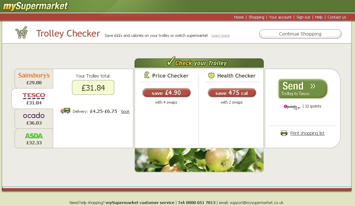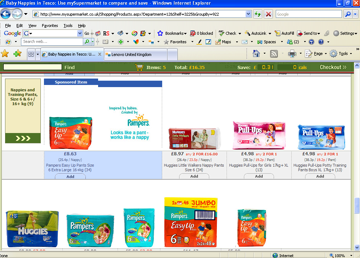The ease of comparing prices on the Internet has done a lot to do away with major price differences between individual items at retailers, whether online or off. But where they still get you is when you buy many items from the same store and you throw in the high-margin coffee with the cut-rate shampoo. Higher-priced single items, such as a digital camera or an MP3 player, lend themselves more to online research. Finding the best deal is just a matter of selecting your preferred comparison shopping site (Shopping.com, mySimon, etc.). But what happens when you want to compare an entire cart of groceries across several merchants? Put simply, you are out of luck. Unless of course you happen to be living in the UK and making good use of mySupermarket.
mySupermarket, which has been around since 2006, claims to be the first comparison service that allows users to compare a cart of multiple items across retailers—in its case, groceries, across British supermarket chains Tesco, Sainsbury’s Ocado & ASDA.
It can compare not only identical items (a one-liter bottle of Coke), but also similar non-identical items, such one-liter bottles of mineral water from two separate brands. To accomplish this, mySupermarket classified 100,000 grocery products sold online in the UK according to multiple criteria and sub-criteria. The rules, weightings and relationships between different sub-criteria are incorporated into the company’s algorithms.
Up-to-date pricing is achieved using a combination of proprietary crawlers and manual validation processes to access real time prices from the supermarkets’ own sites. MySupermarket marries those prices with its own image database. It obtains products from the manufacturers and retailers and then uses in-house image production combined with post-processing facilities in Thailand.
The company claims an average online grocery cart includes approximately 50 items, with a total cost of 80-110 English pounds ($160-$220). By finding savings for consumers that average 20 percent per cart, and consumers accepting about half those recommendations, the actual savings average around 10 pounds ($20) per cart.
The way mySupermarket works is that users login to mySupermarket and fill-up a “trolley” (British for “shopping cart”). They are then presented with three types of recommendations:
1. Potential savings from switching the entire cart to another supermarket.
2. Potential savings from swapping items in the cart to alternatives from within the same supermarket.
3. Health conscious recommendations (calories, saturates, fat, salt, sugar) for swapping items to healthier alternatives.
The final step—payment—is actually performed on the desired supermarket’s own payment page. It should be noted that the service is absolutely free to consumers.
So where does mySupermarket derive its revenue from? Two sources: The first, targeted advertising based on the cart’s contents.
The second, a data service provided to the retailers and merchants which includes price listings, inventory listings (by zipcode), as well as comparison and analysis of products sold within the UK grocery sector. These days mySupermarket is focusing on expanding its UK business, as well as adding features, ad/promotion services and data reporting capabilities.
They are also considering requests to license their technology for non-grocery multi-item comparison shopping.


